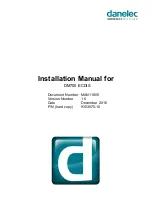
Testing Procedure
Apply power to the unit making sure you have connected the power leads correctly. Both power
leads should be fitted. Check that no device is running hot. Any sign of smoke or strange smells
turn off the power immediately and recheck the polarity of the power supply, and the direction of all
the ICs in their sockets and the polarity of the electrolytic capacitors.
The unit should take around 180 mA from the +15V and the -15V power rails. If the ASV is taking
significantly more than this there is something wrong. The LED should be lit constantly.
Connect a short patch cable between LFO OUT and GATE. The LED should now flash at a speed
determined by the LFO Rate control. The range of the rate control will be adjusted during the
calibration process.
Remove the patch lead and turn the ENV1 Decay pot to its minimum value. Measure the output
voltage on the ENV1 socket. With no jack inserted into the Gate input both envelopes will be in
sustain mode. Check that rotating the Sustain pot on ENV1 from its minimum to maximum makes
the output voltage go from 0V to around 5V. Repeat this process for ENV2.
Plug in your 1V/octave keyboard or midi to CV convertor into the ASV. The pitch control voltage
should be inserted into the Key CV socket and the gate into the gate socket. Pressing a note on your
keyboard should light the little LED.
Listen one by one, or monitor on a oscilloscope, to the two VCO sawtooth outputs. Make sure that
the pitch of both VCOs changes with the note pressed. It will not be in tune but going up the
keyboard should increase the pitch heard. Check that the pitch of each VCO can be changed with its
three position octave switch. Check that VCO2's pitch changes significantly with the VCO2 Tune
control. Check too that the Sync switch locks the pitch of VCO2 so that the VCO2 Tune control
changes only the volume and timbre of the note heard and not the pitch.
Now listen to the pulse wave outputs of each VCO. Check that both pulse wave outputs produce a
square wave sound with their respective Pulse Width controls at their centre point. Square waves
sound more hollow than non square pulse waves.
If you have an oscilloscope you should ensure that all the VCO outputs, both sawtooth and pulse,
are approximately 10V peak to peak. Note that the pulse wave's output will change with respect to
0V; when the pulse is thin the waveform shifts t10V, and when the pulse is fat the shift is
towards -10V. However, the peak to peak value of the pulse output is still always 10V.
Listen to the output of the mixer via the Mixer Out socket. You should be able to use the front
panel's Mixer control to add the chosen outputs of VCO1 and VCO2 together. You should hear
nothing with all three levels at their minimums. Both VCO1 and VCO2 level controls have a
waveform switch next to them. Make sure that the two switches are doing their job properly.
Turn up the Sub/Ext level pot and make sure you can hear the sub-octave output. It should be a
triangle wave although there will be a little extra buzz to it because it is not a pure triangle wave. If
you have a 'scope then you may see little glitches in the waveform near the peaks. Note that the
signal level at the Mixer Out is considerably quieter than the main VCO outputs. With just one
channel turned up full the signal here will be around 3.3V peak to peak, ie. around -10dB lower.
Now pull out the gate connection to the ASV. The unit will be in drone mode once again. Turn
31



































